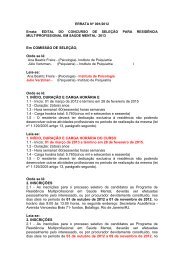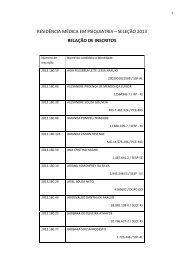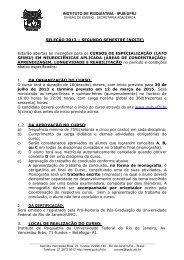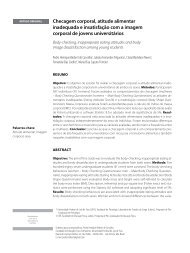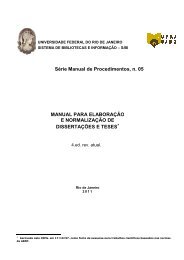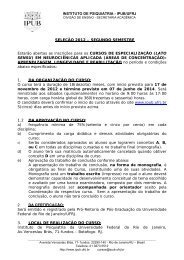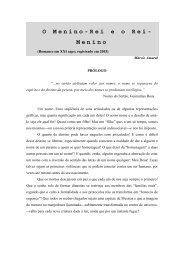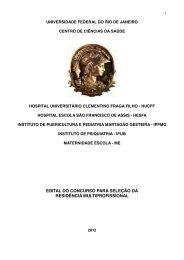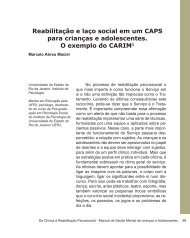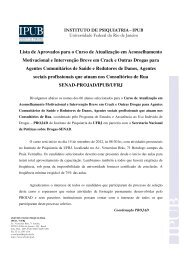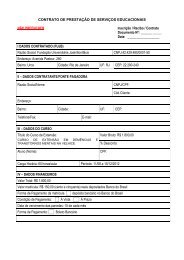Originais â Originals outubro | dezembro ⢠2011 - IPUB - UFRJ
Originais â Originals outubro | dezembro ⢠2011 - IPUB - UFRJ
Originais â Originals outubro | dezembro ⢠2011 - IPUB - UFRJ
You also want an ePaper? Increase the reach of your titles
YUMPU automatically turns print PDFs into web optimized ePapers that Google loves.
306 King ALS et al.<br />
ORIGINAL ARTICLE<br />
Table 2. Comparison between the Intervention and Control groups percentage of responders at the end of treatment period<br />
Tests<br />
Group 1 (G1)<br />
Group 2 (G2)<br />
Sig Dif.**<br />
Baseline 1 Week Baseline 1 Week<br />
Sig Dif.** G1 (%) G2 (%) Sig Dif.**<br />
BAI (Beck Anxiety Inventory) 34.9 ± 11.2 20.0 ± 7.3 0.001 29.3 ± 15.3 26.8 ± 12.0 0.531 60 56 0.116<br />
Sheehan Disability Scale – Total 14.6 ± 3.2 4.4 ± 0.8 < 0.001 13.2 ± 4.3 10.3 ± 4.2 0.228 44 36 0.013<br />
Sheehan Work 5.2 ± 1.1 0.4 ± 0.1 < 0.001 4.0 ± 1.6 3.0 ± 1.8 0.290 52 60 0.001<br />
Sheehan Social 4.8 ± 2.0 2.2 ± 0.6 0.009 4.7 ± 2.0 3.5 ± 2.0 0.195 32 28 0.179<br />
Sheehan Family 4.6 ± 1.9 1.8 ± 0.8 0.005 4.5 ± 1.2 3.8 ± 1.5 0.451 48 44 0.035<br />
Phobic Fear Questionnaire (PFQ) – Total 49.4 ± 17.2 38.3 ± 9.7 0.186 44.6 ± 5.8 39.5 ± 13.2 0.491 56 60 0.872<br />
PFQ – Agoraphobia Score 20.2 ± 3.3 14.7 ± 3.5 0.132 14.1 ± 2.8 14.1 ± 5.7 0.990 64 68 0.860<br />
PFQ – Blood Score 15.6 ± 3.8 11.6 ± 1.8 0.207 15.6 ± 4.8 13.8 ± 3.9 0.531 48 40 0.431<br />
PFQ – Sociability Score 13.7 ± 4.2 12.0 ± 2.1 0.584 14.9 ± 5.0 11.6 ± 5.4 0.118 52 60 0.882<br />
Agoraphobic Cognitions Questionnaire (ACQ) 2.7 ± 0.5 2.1 ± 0.8 0.012 3.9 ± 2.1 2.3 ± 1.3 0.283 60 52 0.233<br />
ACQ – Loss of Control 2.8 ± 1.4 2.1 ± 1.0 0.021 2.3 ± 1.2 2.3 ± 1.2 0.852 68 76 0.384<br />
ACQ – Physical Problems 2.6 ± 0.6 2.0 ± 0.6 0.027 2.7 ± 1.3 2.4 ± 0.9 0.114 44 40 0.161<br />
Body Sensations Questionnaire 3.1 ± 1.0 2.4 ± 1.1 0.008 2.3 ± 1.0 2.4 ± 1.2 0.739 56 52 0.957<br />
Panic and Agoraphobia Scale (PAS) 27.9 ± 8.6 18.6 ± 3.4 0.012 25.5 ± 4.4 22.4 ± 5.3 0.372 64 70 0.304<br />
PAS – Panic Attacks 1.4 ± 0.5 0.7 ± 0.2 0.016 1.4 ± 0.5 1.1 ± 0.7 0.413 72 64 0.149<br />
PAS – Avoidance Agoraphobia 2.4 ± 0.7 1.6 ± 0.5 0.033 1.7 ± 0.8 1.6 ± 0.6 0.596 56 60 0.965<br />
PAS – Anticipated Anxiety 2.9 ± 0.6 2.1 ± 0.9 0.028 2.7 ± 1.2 2.3 ± 1.0 0.235 52 48 0.609<br />
PAS – Disability 2.2 ± 1.0 1.6 ± 1.0 0.109 2.1 ± 0.6 1.9 ± 0.7 0.480 56 52 0.359<br />
PAS – Over precaution 2.1 ± 0.7 1.5 ± 0.8 0.117 2.4 ± 0.7 2.1 ± 0.8 0.465 60 68 0.098<br />
Mobility Inventory - Accompanied 2.4 ± 1.1 1.9 ± 0.5 0.056 2.1 ± 1.1 2.5 ± 1.7 0.353 40 36 0.235<br />
Mobility Inventory - Alone 3.5 ± 0.9 3.0 ± 0.7 0.183 3.2 ± 1.6 3.1 ± 1.4 0.781 52 48 0.869<br />
Global Well-being Assessment 60.8 ± 12.3 72.5 ± 9.2 0.015 66.0 ± 20.4 71.3 ± 25.0 0.139 68 60 0.769<br />
# Evaluation Scales for group 1 (Cognitive Behaviour Therapy and Medication) and Evaluation Scales for group 2 (Control – with Medication and no Cognitive Behaviour Therapy). Results observed between the beginning and the end of the<br />
treatment for both groups.<br />
DISCUSSION<br />
These study results corroborate other research findings 24 ,<br />
which suggest that the combination of CBT with pharmacotherapy<br />
19 produces better results than using therapy alone.<br />
The advent of effective drugs 25 revolutionized the treatment<br />
of psychiatric diseases, reducing the number and length of<br />
hospitalizations and restoring quality of life for patients.<br />
Self-evaluated quality of life evaluation improved, with<br />
reduced phobic-hypochondriac behaviour 26 resulting in<br />
greater freedom in daily life. Not all mental disorders need<br />
to be treated through pharmacological approaches. Other<br />
therapeutic strategies 27 are available, the physician may indicate<br />
the optimal treatment for patients, psychotherapy<br />
alone or in combination with pharmacological treatment. It<br />
is important to establish a good doctor-patient relationship<br />
and discuss all procedures and fears of the patient, such as<br />
becoming medication dependent, of being “different”, sedated,<br />
etc.<br />
Most prior research also restricted surveyed populations<br />
to patients without agoraphobia or with light agoraphobia,<br />
leaving unknown the efficiency of CBT in patients with more<br />
serious agoraphobias 7 . In the population studied, all the patients<br />
showed “with agoraphobia” symptoms.<br />
De-Melo-Neto et al. 22 studied patients with respiratorysubtype<br />
PD with agoraphobia, in which specific hyperventilation<br />
exercises were used for the purpose of producing<br />
symptoms similar to panic. The objective was CR of certain<br />
negative levels of behaviour and response, and the<br />
comprehension by patients that the symptoms expressed<br />
were inoffensive and could be handled. In the present<br />
study, we also had the opportunity to observe the importance<br />
of CR in the sample studied, as this technique made<br />
an important contribution to the reduction of PD related<br />
symptoms.<br />
During the research, it was observed that the satisfactory<br />
evolution of patients depended on several procedures, including<br />
the use of medication prescribed after the psychiatric<br />
evaluation, together with CBT techniques such as SIE, CR,<br />
RR and PMR exercises. At the end of the SIE, patients were<br />
able to perceive that although the sensations produced by<br />
the exercises were similar to those of panic, they did not produce<br />
the feared consequences, were inoffensive, and were<br />
caused by specific stimuli.<br />
J Bras Psiquiatr. <strong>2011</strong>;60(4):301-8.




